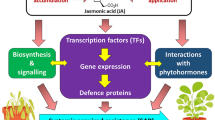Abstract
The potential of hyaluronic acid (HA) in inducing systemic resistance to cucumber, tomato and pepper was tested in planta. In the study, HA was found to be a potent agent for suppressing disease caused by Cucumber Mosaic Virus (CMV) (in pepper), Pseudomonas syringae pv. tomato (tomato speck disease), Xanthomonas axonopodis pv. vesicatoria (tomato spot disease), Pseudomonas syringae pv. lachrymans (cucumber angular leaf spot), and Colletotrichum orbiculare (cucumber anthracnose). Disease control was obtained with spraying, injection and drenching of plants with HA. HA did not exhibit direct antimicrobial action against the pathogens tested. Studies carried out in transgenic tobacco indicated that defense genes PR 1a and PDF 1.2 were activated upon treatment with HA, demonstrating salicylic acid (SA) and jasmonic acid (JA) pathways getting activated during defense. Further work is warranted to evaluate the use of HA-mediated disease suppression in crop plants.



Similar content being viewed by others
References
Akasaka H, Seto S, Yanagi M, Fukushima S, Mitsui T (1998) Industrial production of hyaluronic acid by Streptococcus zooepidemicus. J Soc Cosmet Chem Jpn 22:35–42
Chen Z, Silva H, Klessig DF (1993) Active oxygen species in the induction of plant systemic acquired resistance by salicylic acid. Science 262:1883–1886
Cohen Y, Niderman T, Mosinger E, Flur R (1994) β-aminobutyric acid induces the accumulation of pathogenesis related proteins in tomato plants and resistance to late blight infection caused by Phytophthora infestans. Plant Physiol 104:59–66
Davis KR, Ausubel FM (1989) Characterization of elicitor induced defence responses in suspension-cultured cells of Arabidopsis. Mol Plant Microbe Interact 2:363–368
Epple P, Apel K, Bohlmann H (1997) Over expression of an endogenous thionin enhances resistance of Arabidopsis against Fusarium oxysporum. Plant Cell 9:509–520
Fofana B, McNally D, Labbé C, Boulanger R, Benhamou N, Séguin A, Bélanger RR (2002) Milsana-induced resistance in powdery milldew-infected cucumber plants correlates with the induction of chalcone synthase and chalcone isomerase. Physiol Mole Plant Pathol 61:121–132
Friedrich L, Lawton K, Ruess W, Masner P, Specker N, Gut Rella M, Meier B, Dincher S, Staub T, Uknes S, Metraux JP, Kessman H. (1996) A benzothiadiazole derivative induces systemic acquired resistance in tobacco. Plant J 10(1):61–70
Gorlach J, Volrath S, Knauf-Beiter G, Hengy G, Beckhove U, Kogel KH, Oostendorp M, Staub T, Ward E, Kessmann H, Ryals J (1996) Benzothiadiazole, a novel class of inducers of systemic acquired resistance, activates gene expression and disease resistance in wheat. Plant Cell 8:629–643
Hasegawa S, Nagatsuru M, Shibutani M, Yamamoto S, Hasebe S (1999) Productivity of concentrated hyaluronic acid using a Maxblend® fermentor J Biosci Bioeng 88(1):68–71
Jefferson RA (1987) Assaying chimeric genes in plants: The GUS gene fusion system. Plant Mol Biol Rep 5:387–405
Kessmann H, Staub T, Hofmann C, Maetzke T, Herzog J, Ward E, Uknes S, Ryals J (1994) Induction of systemic acquired resistance in plants by chemicals. Ann Rev Phytopathol 32:439–459
Kunz W, Schurter R, Maetzke T (1997) The chemistry of benzothiadiazole plant activators. Pesticide Science 50:275–82
Lawton KA, Friedrich L, Hunt M, Weymann K, Delaney T, Kessmann H, Staub T, Ryals J (1996) Benzothiadiazole induces disease resistance in Arabidopsis by activation of the systemic acquired resistance signal transduction pathway. Plant J 10:71–82
Metraux JP, Ahl GP, Staub T, Speich J, Steinemann A, Ryals J, Ward E (1991) Induced resistance in cucumber in response to 2,6 dichlroisonicotinic acid, pathogens. In: Hennecke H, Verma DPS (eds) Advances in molecular genetics of plant microbe interactions, vol 1. Kluwer academic publishers, Dordrecht pp 432–439
Park KS, Kloepper JW (2000) Activation of PR 1a promoter by rhizobacteria that induce systemic resistance in tobacco against Pseudomonas syringae pv. tabaci. Biol Control 18:2–9
Smith JA, Hammerschmidt R, Fulbright DW (1991) Rapid induction of systemic resistance in cucumber by Pseudomonas syringae pv. syringae. Physiol Mole Plant Pathol 38:223–235
Staub T, Ahl GP, Kessman H (1992) Chemically induced disease resistance in plants. In: Lyr H, Polter C (eds) Proceedings of the 10th international symposium on systemic fungicides and antifungal compounds, pp 239–249
van Loon LC (1997) Induced resistance in plants and the role of pathogenesis-related proteins. Eur J Plant Pathol 103:753–65
van Loon LC, Bakker PA, Pieterse CM (1998) Systemic resistance induced by rhizophere bacteria. Annu Rev Phytopathol 36:453–483
von Rad U, Mueller JM, Durner J (2004) Evaluation of natural and synthetic stimulants of plant immunity by microarray technology. New Phytol 165:191–202
Ward ER, Uknes SJ, Wlilliams SC, Dinche SS, Wiederhold DL, Alexander DC, Ahl-Goy P, Metraux JP, Ryals JA (1991) Coordinate gene activity in response to agents that induce systemic acquired resistance. Plant Cell 3:1085–1094
Yang KY, Blee KA, Zhang S, Anderson AJ (2002) OxycomTM treatment suppresses Pseudomonas syringiae infection and activates a mitogen activated protein kinase pathway in tobacco. Physiol Mol Plant Pathol 61:249–256
Yoshioka K, Nakashita H, Klessig DF, Yamaguchi I (2001) Probenazole induces systemic acquired resistance in Arabidopsis with a novel type of action. Plant J 25(2):149–157
Author information
Authors and Affiliations
Corresponding author
Rights and permissions
About this article
Cite this article
Park, K., Paul, D., Kim, E. et al. Hyaluronic acid of Streptococcus sp. as a potent elicitor for induction of systemic resistance against plant diseases. World J Microbiol Biotechnol 24, 1153–1158 (2008). https://doi.org/10.1007/s11274-007-9587-0
Received:
Accepted:
Published:
Issue Date:
DOI: https://doi.org/10.1007/s11274-007-9587-0




